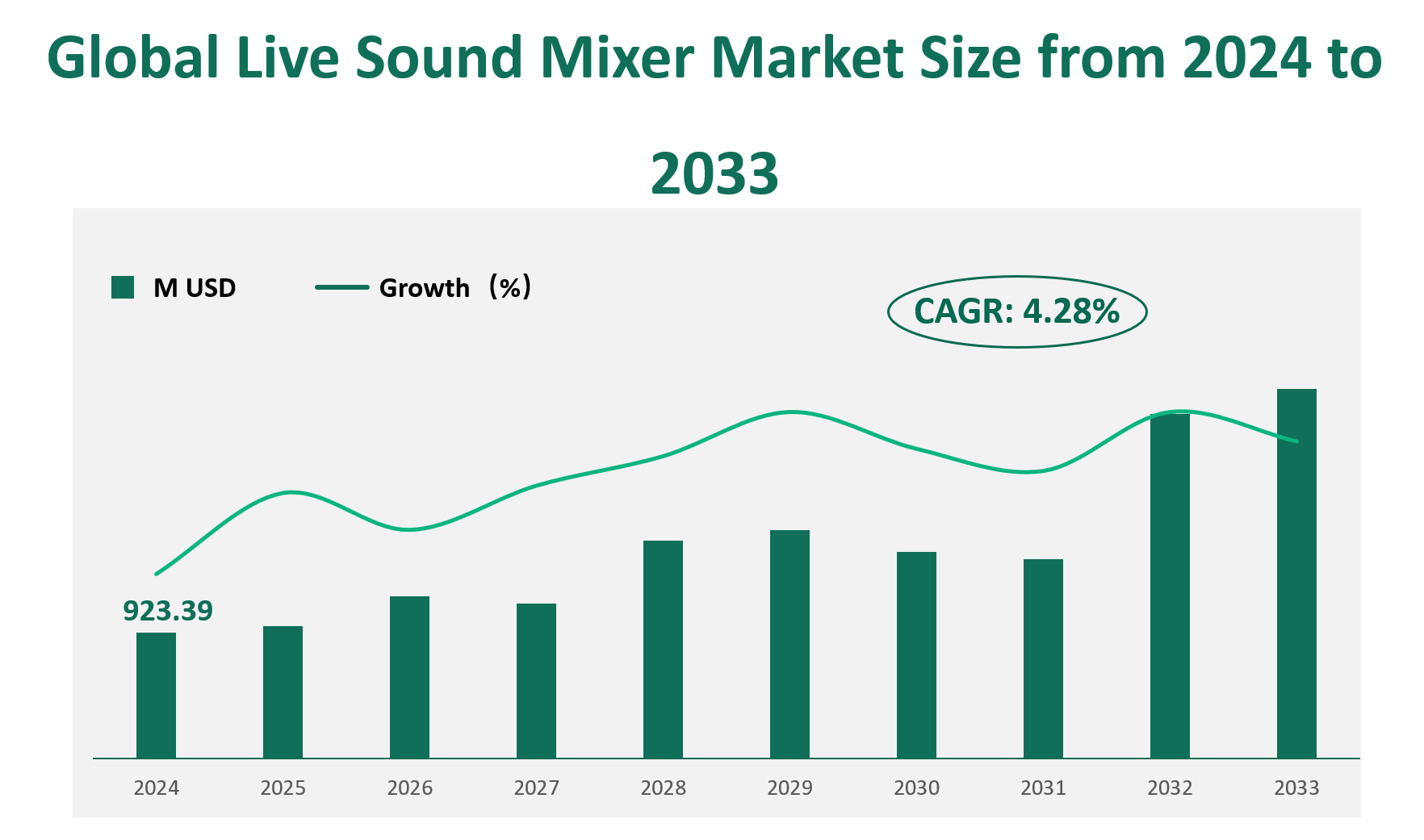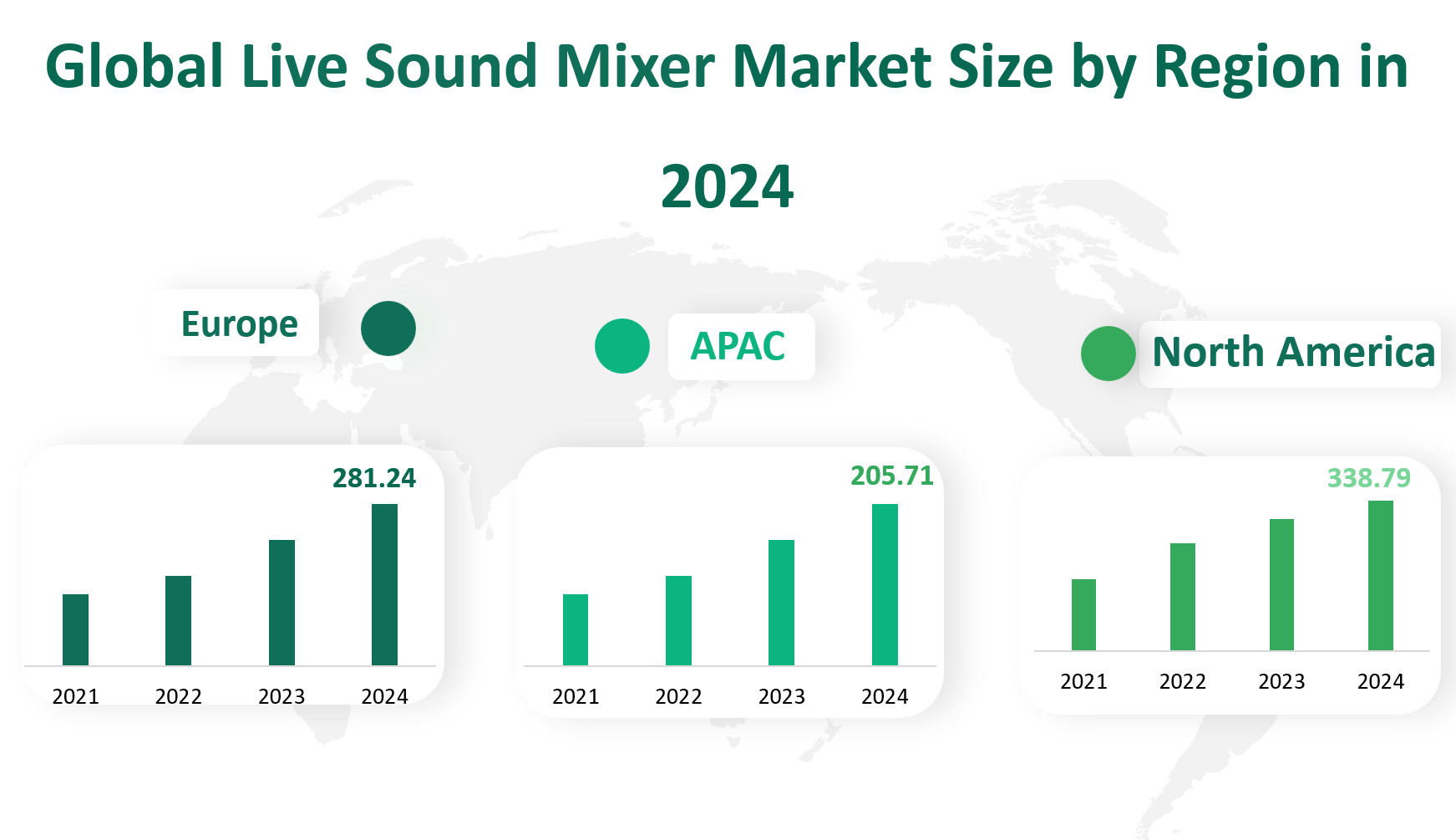1. Global Live Sound Mixer Market Insight Analysis
The global Live Sound Mixer market is projected to reach a revenue of $923.39 million in 2024, with a Compound Annual Growth Rate (CAGR) of 4.28% from 2024 to 2033.
A Live Sound Mixer is a critical component in the audio industry, designed to combine multiple audio signals from various sources, process them, and route them to one or more destinations. These devices are essential in live performances, such as concerts, theater shows, and conferences, where high-quality audio mixing is crucial for delivering an optimal listening experience. Live Sound Mixers come in various types, including digital mixers, analog mixers, and powered mixers, each catering to different needs and preferences. Digital mixers, in particular, have gained significant traction due to their flexibility, advanced features, and ability to integrate seamlessly with modern audio systems.
Figure Global Live Sound Mixer Market Size (M USD) and CAGR (2024-2033)

2. Driving and Limiting Factors of Live Sound Mixer Market Growth
The growth of the Live Sound Mixer market is influenced by a variety of factors that can be categorized into driving forces and limiting factors. On the positive side, the increasing demand for live sound mixer equipment at live concerts, exhibitions, and trade shows has significantly boosted the market. This surge in demand is driven by the expanding entertainment industry, where high-quality sound reinforcement is essential for enhancing the audience experience. The use of live sound mixers in sports and games, educational institutions, and corporate events also plays a crucial role in driving market growth. As these sectors continue to grow and prioritize audio quality, the need for advanced and reliable live sound mixers increases.
Technological advancements have further propelled the market forward. Digital mixers, in particular, have gained popularity due to their flexibility, compactness, and superior sound quality. These mixers offer sophisticated channel equalizers, in-line dynamics, and advanced routing options, making them ideal for a wide range of applications. The integration of wireless technology and the Internet of Things (IoT) in educational institutions has also created new opportunities for live sound mixers, as smart campuses seek to enhance interaction between learners and educators through modern audio equipment.
However, the Live Sound Mixer market also faces several limiting factors. One significant challenge is the low price competition, which reduces industry profits. As price-conscious customers increasingly seek out the cheapest suppliers, online channels have driven down prices, leading to lower profit margins for manufacturers. Rising labor costs in various regions of the world have also put pressure on manufacturers, as the production of live sound mixers is labor-intensive. Additionally, fluctuations in raw material prices have increased manufacturing costs, further squeezing profit margins.
Another limiting factor is the threat of alternative products. While high-quality live mixing consoles are expensive, cheaper alternatives can reliably handle a variety of sound reinforcement applications. This has led some consumers to opt for lower-cost options, posing a challenge for major manufacturers. The inflexibility of analog mixers, which often require additional switching systems or patch bays, is another limitation. Despite their suitability for medium to large sound reinforcement applications, analog mixers struggle to meet the demands of touring and technically demanding performances.
3. Technology Innovation and Corporate Mergers and Acquisitions in Live Sound Mixer Market
The Live Sound Mixer market has witnessed significant technological innovations and corporate activities that have shaped its development. Technological advancements have been a key driver of growth, particularly in the area of digital mixers. These mixers have revolutionized the industry by providing advanced features such as digital signal processing, graphic equalizers, and flexible routing options. The integration of IoT and wireless technology has further enhanced the capabilities of live sound mixers, making them more versatile and user-friendly. Companies have also focused on improving sound quality, reducing noise levels, and enhancing the overall user experience through continuous innovation.
Corporate mergers and acquisitions have played a crucial role in consolidating the market and expanding the reach of key players. For example, Yamaha’s acquisition of Ampeg in 2018 has strengthened its position in the market by adding a renowned brand to its portfolio. Denon DJ’s acquisition of Onesixone (SoundSwitch) has enabled the company to integrate innovative software-hardware solutions into its product offerings, enhancing its capabilities in the DJ and live performance segments. These strategic moves not only expand the product range of companies but also provide them with access to new technologies and customer bases.
Other notable developments include the introduction of new product models and the expansion of companies into new regions. For instance, Mackie’s launch of the SRM V-Class series of powered loudspeakers demonstrates the company’s commitment to innovation and meeting the evolving needs of professional sound reinforcement applications. Similarly, PreSonus Audio Electronics’ introduction of the StudioLive 64S digital mixer has expanded its product offerings and enhanced its position in the market.
4. Global Live Sound Mixer Market Size by Type
Live sound mixers are essential tools in the audio industry, used to combine, control, and enhance audio signals from multiple sources. The market for live sound mixers can be segmented into three primary product types: Digital Mixers, Analog Mixers, and Powered Mixers.
Digital mixers use digital signal processing (DSP) to handle audio signals. They offer advanced features such as sophisticated equalization, dynamics processing, and effects, often with the ability to recall settings and configurations. Digital mixers are highly flexible and can be controlled via software interfaces, making them ideal for complex setups and live performances. The digital mixers segment is projected to generate a revenue of approximately 584.85 million USD in 2024.
Analog mixers process audio signals using analog circuits. They are known for their simplicity and reliability, making them popular in applications where ease of use and durability are paramount. Analog mixers are often preferred for their warm sound quality and straightforward operation. The analog mixers segment is expected to generate a revenue of around 96.24 million USD in 2024.
Powered mixers combine the functionality of an analog mixer with built-in amplifiers. This allows for direct connection to speakers, simplifying setup and operation. Powered mixers are particularly popular in portable applications and small venues due to their convenience and ease of use. The powered mixers segment is projected to generate a revenue of approximately 242.30 million USD in 2024.
Table Global Live Sound Mixer Market Size by Type in 2024
5. Global Live Sound Mixer Market Size by Application
The live sound mixer market serves a variety of applications, each with its own unique requirements and market dynamics. The primary applications include Performance, Learning and Teaching, and Entertainment.
The performance application refers to the use of live sound mixers in concerts, theater performances, large-scale events, and conferences. These applications require high-quality audio mixing and the ability to handle multiple sources and complex setups. The performance application segment is projected to generate a revenue of approximately 318.21 million USD in 2024.
The learning and teaching application refers to the use of live sound mixers in educational institutions, lecture halls, and training centers. These applications require reliable and easy-to-use audio solutions to enhance the learning experience. The learning and teaching application segment is expected to generate a revenue of around 134.70 million USD in 2024.
The entertainment application refers to the use of live sound mixers in bars, clubs, and other entertainment venues. These applications require robust and reliable audio solutions to enhance the overall entertainment experience. The entertainment application segment is projected to generate a revenue of approximately 470.48 million USD in 2024.
Table Global Live Sound Mixer Market Size by Application in 2024
Application | Market Size (M USD) 2024 |
Performance | 318.21 |
Learning and Teaching | 134.70 |
Entertainment | 470.48 |
6. Global Live Sound Mixer Market by Top Regions
The North American live sound mixer market is projected to generate a revenue of approximately 338.79 million USD in 2024. North America has historically been the largest market by revenue, accounting for a significant share of the global live sound mixer market.
The European live sound mixer market is expected to generate a revenue of approximately 281.24 million USD in 2024. The European market benefits from a strong presence of major manufacturers and a high demand for high-quality audio equipment in live performances and educational institutions.
The Asia Pacific live sound mixer market is projected to generate a revenue of approximately 205.71 million USD in 2024. This growth is driven by the increasing demand for live sound mixers in emerging markets such as China, Japan, and South Korea, as well as the growing popularity of live events and concerts.
The South American live sound mixer market is expected to generate a revenue of approximately 48.01 million USD in 2024.
The Middle East & Africa live sound mixer market is projected to generate a revenue of approximately 49.63 million USD in 2024.
Figure Global Live Sound Mixer Market Size by Region in 2024

7. Global Live Sound Mixer Market Analysis by Major Players
7.1 Yamaha
Company Introduction and Business Overview: Yamaha is a leading manufacturer of musical instruments and audio equipment, with a strong presence in the live sound mixer market. Founded in 1955, Yamaha is headquartered in Japan and operates worldwide.
Products Offered: Yamaha offers a wide range of live sound mixers, including digital mixers, analog mixers, and powered mixers. Their products are known for their high quality and advanced features, making them popular in live performances, educational institutions, and entertainment venues.
7.2 Harman (Soundcraft)
Company Introduction and Business Overview: Harman (Soundcraft) is a subsidiary of Harman International, a leading manufacturer of professional audio equipment. Founded in 1973, Soundcraft is headquartered in the USA and operates worldwide.
Products Offered: Soundcraft offers a wide range of live sound mixers, including digital mixers, analog mixers, and powered mixers. Their products are known for their reliability and advanced features, making them popular in live performances and educational institutions.
7.3 Mackie
Company Introduction and Business Overview: Mackie is an American professional audio products brand, known for its affordable and versatile compact pro audio mixers. Founded in 1988, Mackie is headquartered in the USA and operates worldwide.
Products Offered: Mackie offers a wide range of live sound mixers, including digital mixers, analog mixers, and powered mixers. Their products are known for their durability and ease of use, making them popular in live performances and small-scale events.

